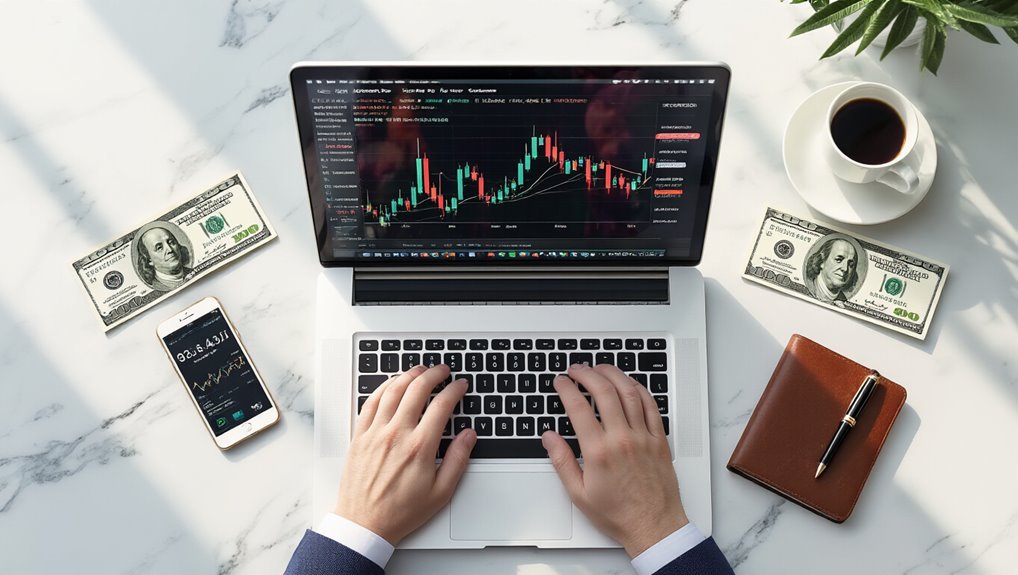Day trading demands solid market fundamentals, proper equipment, and disciplined strategies before risking real money. Beginners need high-performance computers, multiple monitors, reliable internet, and platforms like TradingView for chart analysis. Popular strategies include Gap and Go trading, the 50 EMA method with 65% win rates, and momentum trading using technical indicators.
Risk management proves critical through stop-loss orders, position sizing, and maintaining trading journals. Success requires consistent routines and emotional control to avoid revenge trading. Master these essentials to build a foundation for profitable trading ventures.
Essential Knowledge and Skills You Need Before Trading

Before risking real money, beginners must master fundamental market mechanics. Supply and demand imbalances create the price swings traders exploit. When buying demand exceeds selling supply, prices rise. Simple concept. Complex execution.
Essential knowledge starts with basic terminology. Bid prices. Ask prices. Stop-loss orders. Going long versus short selling. These aren’t suggestions—they’re requirements. Trading platforms become second nature through practice. Paper trading eliminates financial risk while building skills.
Technical analysis forms the foundation. Chart reading, especially candlestick patterns, reveals market sentiment. Support and resistance levels indicate potential entry and exit points. Different time frames can reveal distinct trading opportunities depending on your strategy. However, no single indicator guarantees success. Traders who understand this survive. Those who don’t get crushed.
Market instruments vary widely. Stocks, ETFs, options, inverse ETFs—each operates differently. Knowledge gaps here cost money fast. Study first. Trade later. Successful traders maintain detailed trading journals to analyze their performance and identify improvement opportunities. Implementing proper position sizing is crucial for preserving capital while maximizing potential growth in your trading account.
Setting Up Your Trading Foundation and Tools
Knowledge means nothing without proper tools.
Day traders need specific hardware and software to compete effectively. A high-performance computer handles multiple applications simultaneously. Multiple monitors allow traders to view charts, news feeds, and brokerage platforms at once. High-speed internet guarantees real-time data streaming and fast order execution.
| Hardware Essentials | Software Requirements |
|---|---|
| High-performance computer | TradingView charting platform |
| Multiple monitors | Low-latency brokerage account |
| Reliable internet connection | Stock scanner with alerts |
| UPS backup power | Trading journal software |
TradingView stands out for charting due to its intuitive interface and technical indicators. Brokers must offer fast execution with low latency. Zero-commission platforms reduce costs but execution quality varies.
Stock scanners identify opportunities through volume spikes and price breakouts. These tools can quickly identify biggest gainers and losers in the market based on predetermined criteria. Market dashboards consolidate real-time data into single views.
Trading journals track performance metrics. Position size calculators and risk management tools help traders protect capital through proper trade sizing and stop-loss placement. TraderSync automates this process. Digital records enable strategy refinement through periodic review. Paper trading accounts provide essential practice opportunities without financial risk before transitioning to live markets.
Popular Day Trading Strategies for Beginners
Strategy selection separates profitable traders from those who blow up accounts. Beginners need proven approaches that work.
The Gap and Go strategy targets stocks gapping 4% or more at open. Find the catalyst. Enter within thirty minutes. Exit by 10 AM. Speed matters.
Simple Moving Average strategies offer clarity. The 50 EMA method shows 65% win rates in backtesting. Buy above the line. Sell below it. Clean signals for new traders.
Momentum trading exploits strong directional moves. MACD, RSI, and Stochastic Oscillator guide entries and exits. Enter when momentum builds. Exit when it fades. Watch for MACD divergence signaling reversals.
Technical analysis reads market psychology through price patterns. Support and resistance levels mark entry points. Charts reveal sentiment shifts across stocks and ETFs. Setting take-profit orders helps secure gains automatically once price targets are reached.
Swing trading captures multi-day moves. Combine fundamentals with technical signals. Trade volatile instruments. Target price swings lasting days to weeks. Both long and short positions work. Beginners should aim for 1-3% monthly returns while building experience and refining their strategy.
Breakout trading enters positions when stocks break through key resistance or support levels with increased volume.
Each strategy demands discipline and practice.
Managing Risk and Developing Trading Discipline

Why do 80% of day traders lose money within their first year? Poor risk management and lack of discipline.
Setting maximum risk levels before trading protects capital from impulsive decisions. Traders must assess risk tolerance honestly, balancing comfort with potential losses. Conservative traders adopt lower limits. Aggressive traders accept higher risk for greater gains.
Position sizing determines trade amounts based on capital and risk tolerance. Smaller positions reduce exposure. The ratio of risk per share and shares traded defines total financial risk. The one-percent rule limits maximum risk to just one percent of total account balance per individual trade.
| Risk Management Tool | Purpose |
|---|---|
| Stop-Loss Orders | Automatically limit losses at predetermined points |
| Take-Profit Points | Lock in gains at set profit levels |
| Position Sizing | Control exposure based on capital |
| Risk-Reward Ratios | Express potential loss versus expected gain |
Developing trading discipline requires consistent routines. Plan trades. Set risk parameters. Review results regularly. Paper trading builds confidence without risking real capital. Cut losses quickly when markets move against positions. After experiencing losses, stepping back temporarily helps traders avoid revenge trading and maintain emotional control. Risk management requires ongoing adjustment as market conditions change and traders gain experience. Successful traders recognize that market risk remains outside their control while focusing on managing their individual responses to market movements.
Frequently Asked Questions
How Much Money Can I Realistically Make Day Trading as a Beginner?
Beginners face harsh realities in day trading. Most novices lose money—70% to 90% fail completely. Only 4% to 15% achieve consistent profits. Successful traders earn 1% to 4% monthly, requiring substantial capital for meaningful income. With a $10,000 account, realistic daily profits range from $3 to $13. New traders need patience, extensive learning, and should expect losses initially. Starting small means slow growth and requires significant time commitment.
What Are the Tax Implications of Day Trading Profits and Losses?
Day trading profits face ordinary income tax rates, not favorable capital gains treatment. Rates range from 10% to 37% federally. Losses offset gains plus $3,000 of other income annually. Trader Tax Status with mark-to-market accounting simplifies reporting and removes wash sale restrictions. Business expenses become deductible. Trading profits avoid self-employment tax but may trigger the 3.8% Net Investment Income Tax on high earners.
How Many Hours per Day Should I Dedicate to Day Trading?
Beginners should dedicate 2-3 hours daily to day trading. The ideal window is 9:30-11:30 AM EST when volatility peaks. Trading longer leads to fatigue and costly mistakes. Most successful traders focus on these “golden hours” for maximum profit potential. Personal schedule and trading style influence duration, but concentrated sessions work better than marathon trading days. Quality over quantity matters more than extended screen time.
Can I Day Trade With a Full-Time Job or Other Commitments?
Day trading with a full-time job presents serious obstacles. Market hours demand constant attention during vital openings and closings. Limited availability restricts participation when it matters most. The dual commitment increases stress and compromises performance in both areas. Success rates plummet without dedicated focus. Most profitable traders spend six to eight hours daily monitoring markets. Balancing both rarely works effectively.
What Happens if I Lose All My Day Trading Capital?
Losing all day trading capital means immediate trading cessation unless new funds arrive. FINRA data shows 72% of traders lose money annually, with 65% losing everything. Beyond the financial hit, psychological stress kicks in hard. Many quit within a month. Recovery requires multiple consecutive wins—statistically unlikely. Leveraged positions can create debt beyond initial capital. Platforms may impose account restrictions. Most traders never recover from total losses.
Conclusion
Day trading demands preparation. New traders must master market fundamentals first. Technical analysis skills aren’t optional. Risk management separates survivors from casualties. Most beginners lose money initially. The statistics are brutal. Proper education takes months, not days. Platform familiarity is vital before risking real capital. Emotional discipline determines long-term success. Start small. Learn constantly. Expect losses while developing skills. Success requires treating trading like a business, not gambling.



